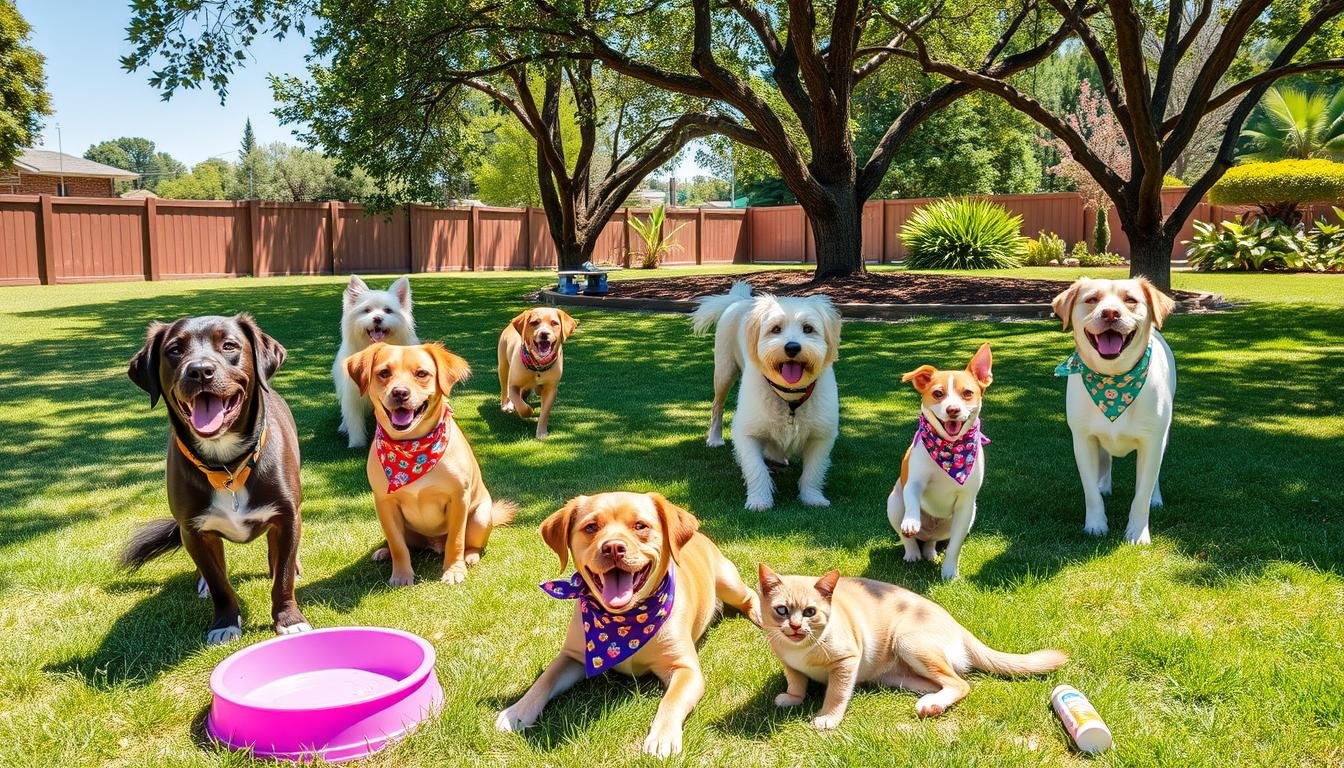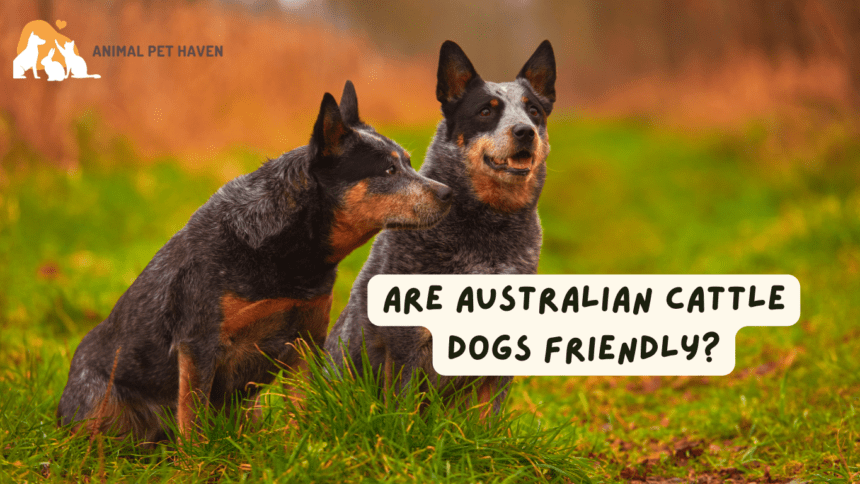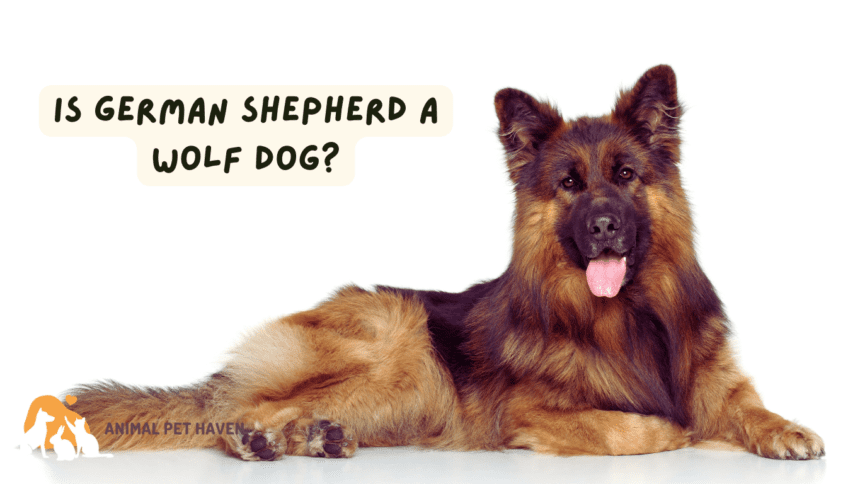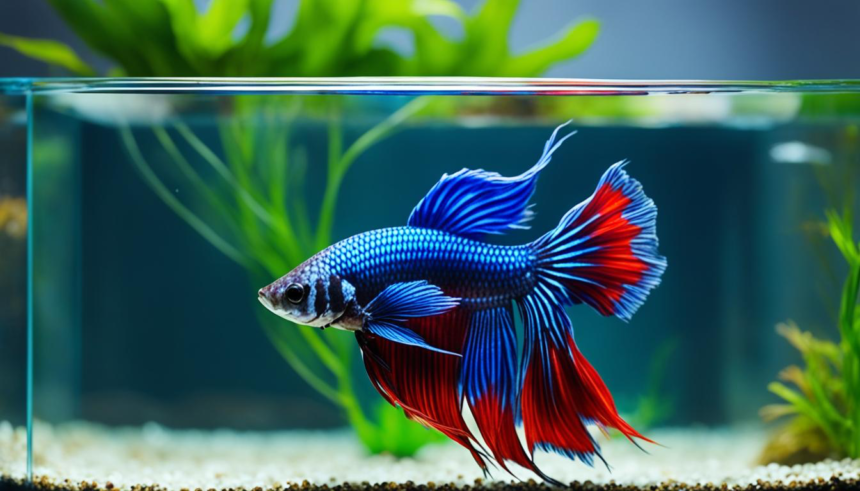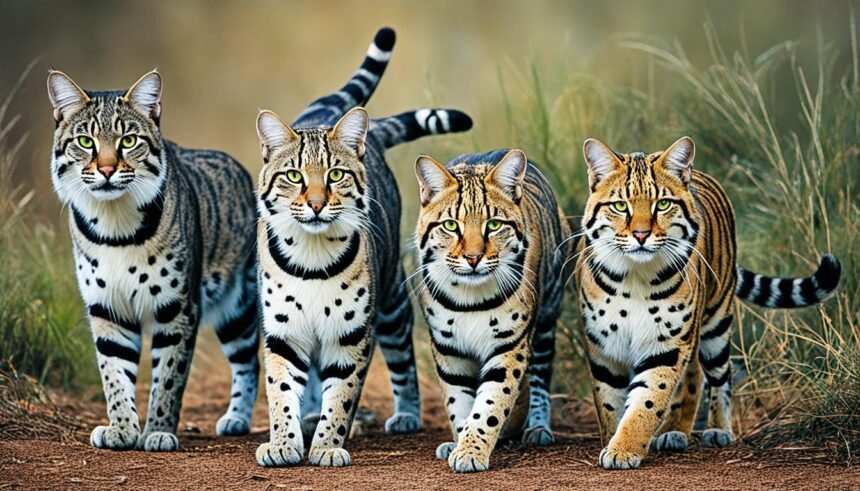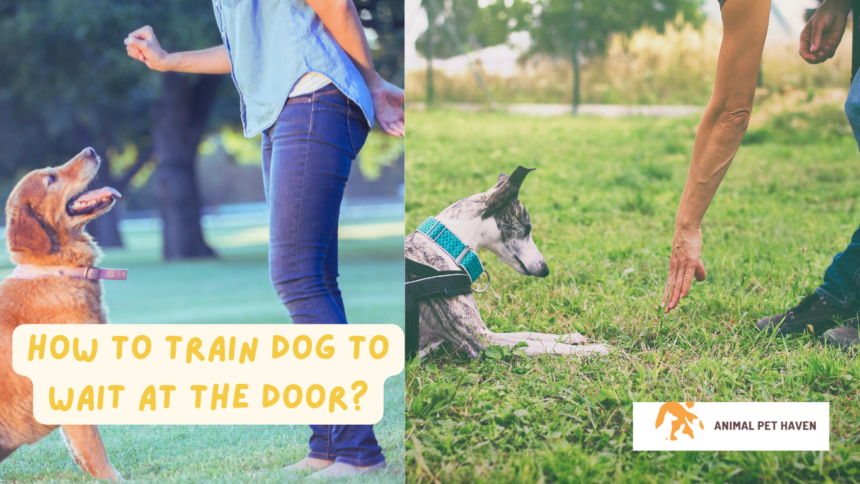Summer brings challenges for pet owners to keep pets safe in the heat. It’s important to plan and care for your furry friends all summer.
When it gets hot, pets can’t cool down like humans do. They are at risk for heat-related problems. Knowing how to keep them safe can prevent health issues and keep them comfortable.
Good summer pet care means watching how much they move, keeping them cool inside, and making sure they drink enough water. These steps help protect them from extreme temperatures.
Vets say it’s key to be proactive about summer pet safety. Change their exercise, give them always-accessible water, and watch for signs of heat stress.
Pet owners need to watch out for dangers like hot pavement and too much sun. Using all the summer safety tips can really help your pet stay safe and happy.
Knowing what your pet needs in the heat is key. Every pet is different, so make sure your care plan fits their needs. This way, you can give them the best summer care.
Understanding Heat Risks for Pets During Summer
Summer heat can be dangerous for pets, with heatstroke posing a serious threat to their health and well-being. Different animals have varying levels of susceptibility to heat stress. It’s important for pet owners to understand the risks and warning signs.
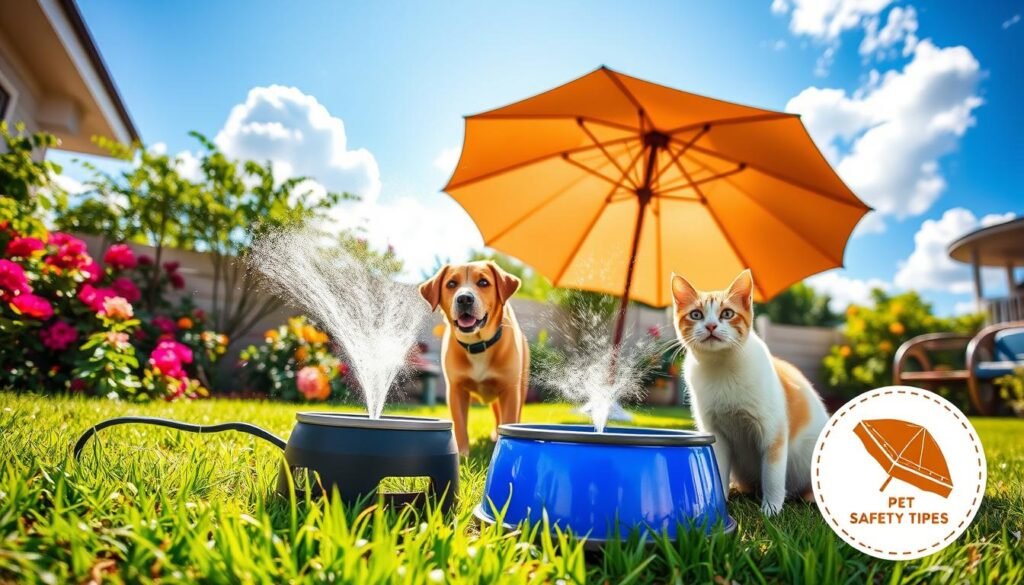
Pets can quickly become overheated, with some breeds being more vulnerable than others. Short-nosed pets like bulldogs, pugs, and Persian cats are at high risk. This is because they have restricted airways and struggle to regulate their body temperature.
Signs of Overheating in Dogs and Cats
Recognizing the early signs of heat stress can be lifesaving. Watch for these critical indicators:
- Excessive panting or difficulty breathing
- Increased heart and respiratory rate
- Drooling or sticky saliva
- Weakness or sudden lethargy
- Bright red or pale gums
- Vomiting or diarrhea
- Confusion or disorientation
Critical Temperature Thresholds
Body temperature is a critical indicator of heat-related problems. Normal pet body temperatures range between 101-102.5°F. When internal temperatures rise above 104°F, pets enter the danger zone for heat stroke.
High-Risk Pet Breeds
“Not all pets handle heat equally. Some breeds are more vulnerable than others.” – Veterinary Heat Safety Guide
Certain pets are more susceptible to heat stroke, including:
- Brachycephalic (short-nosed) breeds
- Overweight animals
- Older pets
- Animals with thick fur coats
- Pets with underlying health conditions
Prevention is always better than treatment. Keep your pets cool, provide plenty of water, and avoid strenuous activities during peak heat hours.
Hydration Strategies to Keep Your Pet Safe
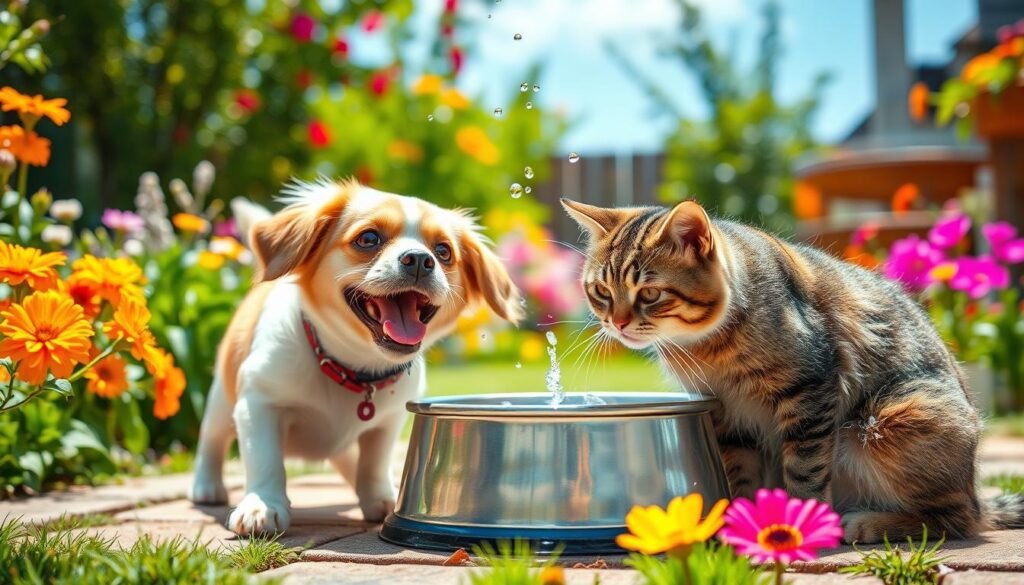
July is National Pet Hydration Awareness Month. It’s a time to focus on keeping your pets hydrated in the summer. Pets lose water fast in the heat, so it’s key to keep them hydrated.
Dehydration can be very bad for dogs and cats. Vets say pets get dehydrated quicker than people. This can lead to:
- Kidney problems
- Urinary tract infections
- Potential heatstroke
To keep your pet hydrated, try these tips:
- Make sure they always have fresh, cool water
- Use water fountains to make drinking more appealing
- Give them ice cubes as a cool treat
- Let them drink small amounts of cool water often
“Hydration is more than just water—it’s about keeping your pet healthy and comfortable during summer months.”
Look out for dehydration signs like dry gums, sunken eyes, and too much panting. Brachycephalic breeds like French bulldogs and pugs need extra water.
Pro tip: Mix wet food into their diet. Also, make fun hydrating treats like frozen melon or low-sodium chicken broth ice cubes. This makes staying hydrated fun for your pets.
Summer Pet Care: Creating Cool Indoor Spaces
Summer heat can be tough on pets, making indoor comfort key. Keeping pets cool is a must during hot months. This ensures they stay safe and comfy in your home.
Pet-Friendly Cooling Zones
Creating cozy indoor spaces helps pets stay cool and avoid heat stress. Here are some tips:
- Position fans to create air circulation
- Use cooling mats in strategic locations
- Darken rooms with light-blocking curtains
- Provide access to tile or hardwood floors
Indoor Recreational Activities
When it’s hot outside, indoor fun is vital for pets. It keeps them mentally sharp and active. Here are some fun ideas:
- Hide treats around the house for mental stimulation
- Play interactive puzzle games
- Use laser pointers for cats
- Create indoor obstacle courses
Temperature Management Tips
Managing temperature effectively helps keep pets cool and safe. Here are some tips:
- Keep curtains drawn during peak heat hours
- Ensure proper home ventilation
- Use air conditioning consistently
- Create a dedicated cool zone with water access
“A cool pet is a happy pet” – Veterinary Summer Care Guide
By using these strategies, you can make a cool, safe space for your pets on hot summer days.
Safe Exercise and Outdoor Activities
Summer brings challenges for pet exercise and outdoor fun. Keeping your furry friend safe from heat is key. You need to plan carefully and watch their comfort and safety closely.
The best times for outdoor fun are in the morning or evening when it’s cooler. Stay indoors during the hottest times to avoid heat risks.
“A smart pet owner knows when to move your pet to a safer, cooler environment.” – Veterinary Summer Safety Guide
Smart Summer Exercise Strategies
- Schedule walks during cooler morning or evening hours
- Keep outdoor sessions short and controlled
- Always provide fresh water and shade
- Watch for signs of fatigue or overheating
When it’s really hot, find indoor or cooler activities. Indoor play, swimming, and low-impact games are great. If your pet looks stressed, get them to shade and give them water right away.
Activity Recommendations
- Indoor fetch or tug games
- Puzzle toys for mental stimulation
- Short, gentle walks in shaded areas
- Water play in shallow, cool pools
Every pet is different when it comes to heat. Keep a close eye on your pet and adjust activities to keep them safe and happy in the summer.
Protecting Pet Paws from Hot Surfaces
Summer heat turns sidewalks and streets into dangers for pets. The asphalt quickly becomes very hot. This can cause painful burns to your pet’s paw pads in seconds.
As temperatures go up, pavements get scorching hot. At 85 degrees Fahrenheit, asphalt can hit 135 degrees. This is hot enough to cook an egg and can burn your pet’s delicate feet.
Recognizing Dangerous Surface Temperatures
To check if a surface is safe, use the 5-second hand test:
- Place your hand on the pavement for 5 seconds
- If it’s too hot for your hand, it’s too hot for pet paws
- Avoid walking during peak heat hours (typically 10 am to 4 pm)
Paw Protection Methods
Keep your pet’s paw pads safe with these methods:
- Use dog booties with rubber soles
- Apply protective paw balms
- Walk on grass or shaded areas
- Choose early morning or late evening walks
Treatment for Burned Paw Pads
If your pet’s paws get burned, act fast:
- Rinse paws with cool water
- Apply a cold compress
- Avoid breaking any blisters
- Seek veterinary care for serious burns
“Prevention is always better than treatment when it comes to protecting your pet’s delicate paw pads.” – Veterinary Experts
Regular paw care and awareness can help keep your furry friend safe during hot summer days.
Water Safety and Swimming Guidelines
Swimming can be a fun summer activity for pets. But, water safety is very important. Not all dogs are good swimmers, and some breeds have special challenges in water.
It’s key for pet owners to know about water safety. Dogs like Bulldogs, Pugs, and Dachshunds might find swimming hard. They need extra help and watchful eyes near water.
- Use a properly fitted doggy life vest for added safety
- Supervise pets closely during water activities
- Introduce swimming gradually to build confidence
- Avoid forcing pets into water
There are important swimming guidelines to follow. Dogs prefer water between 60-75 degrees Fahrenheit. Also, wait 1-2 hours after eating before swimming to avoid stomach problems.
“A well-prepared pet is a safe pet when enjoying water activities.”
There are risks like dry drowning from too much water. Look out for signs like trouble breathing, wheezing, or feeling very tired after swimming.
- Rinse pets thoroughly after swimming to remove chlorine or salt
- Provide fresh drinking water
- Avoid letting pets drink pool or lake water
- Be cautious of strong currents or waves
By following these guidelines, pet owners can make sure their pets have a safe and fun swim.
Summer Grooming and Coat Maintenance
Keeping your pet cool in summer means you need to groom them right. The warm weather brings special challenges for pet owners. So, grooming is key to your pet’s care.
Experts say there’s a 70% jump in haircuts for pets in summer. It’s not just about looks. It’s about keeping your pet cool, comfy, and healthy.
Proper Grooming Techniques
- Brush your pet daily to reduce shedding by up to 50%
- Use the right brushes for different coat types
- Check for parasites during grooming sessions
- Remove loose fur to prevent overheating
Seasonal Coat Care Tips
Don’t shave double-coated breeds. Their fur keeps them cool and protected from the sun. Instead, focus on:
- Trimming long hair around paw pads
- Preventing matting which can trap heat
- Using pet-specific shampoos
- Keeping nails trimmed for comfort
Sun Protection Measures
Use pet-safe sunscreen on areas like ears and noses to protect from sunburn. Pets with light or thin coats are more at risk.
“Regular grooming is not just about looks—it’s about your pet’s health and comfort during summer.” – Veterinary Grooming Experts
By following these summer grooming tips, you’ll keep your pet cool, clean, and safe all summer long.
Preventing Summer Parasites and Pests
Summer is the perfect time for parasites and pests to harm your pet. It’s important to know about these risks to keep your pet safe.
Flea and tick prevention is key in the hot and humid weather. These tiny pests can spread serious diseases. So, protecting your pet is a must for pet owners.
- Ticks can spread dangerous illnesses like Lyme disease and Rocky Mountain spotted fever
- Mosquitoes pose significant heartworm transmission risks
- Fleas can cause intense itching and possible anemia
Heartworm disease is more common in summer. It can lead to serious heart problems if not treated. Daily prevention is key to protecting your pet’s long-term health.
“Prevention is always better than cure when it comes to summer parasites” – Veterinary Health Experts
Protect your pet with a good parasite prevention plan:
- Consult your veterinarian about the right treatments
- Check for ticks after being outside
- Keep your yard clean and well-maintained
- Use pet-safe insect repellents when needed
Look out for signs of parasites, like too much scratching or unusual skin. Catching these early can help your pet have a happy, healthy summer.
Vehicle Safety and Travel Precautions
Traveling with your pet needs careful planning and safety focus. The car can quickly turn dangerous without the right precautions. Knowing the risks and preparing well can make trips safer and more fun for you and your pet.
Car temperatures can rise fast. Studies show a car’s inside can go up by 20 degrees in 10 minutes. After an hour, it can be up to 40 degrees hotter. So, never leave your pet in a car, even with windows open a bit.
Car Temperature Awareness
- Avoid leaving pets in parked vehicles during any season
- Check vehicle temperature before bringing your pet along
- Use car air conditioning or ventilation systems
- Carry a portable thermometer to monitor car interior heat
Travel Safety Essentials
When you’re traveling with your pet, safety is key. Unrestrained pets can be a distraction and risk injury during sudden stops.
- Use pet restraints or secured carriers
- Avoid letting pets sit on the driver’s lap
- Keep pets away from airbag zones
- Secure pets during sharp turns or sudden stops
Emergency Preparedness
Being ready for unexpected situations is important for pet travel safety. Have a pet travel kit with water, medications, first-aid, and ID documents.
“The best travel companion is a prepared one.” – Veterinary Travel Safety Guide
By following these tips, you can ensure a safe and comfy trip with your pet. This way, you both can enjoy the journey without risks.
Conclusion
Keeping pets safe in the summer is key. Veterinary experts say it’s all about being proactive and watching closely. Dehydration, heat stress, and health risks need our full focus and planning.
Knowing how to keep pets safe in summer is vital. It’s about keeping them hydrated, cool, and protected from parasites. Limiting their time outside when it’s hottest is also important. Each step helps make their summer better.
Pet owners must stay alert and flexible. Regular vet visits, always having fresh water, and comfy indoor spots are essential. By focusing on your pet’s comfort and health, you can help them get through the summer.
Good summer pet care is about watching closely, planning ahead, and caring for your pet’s health. Making a few changes to their routine and environment can greatly reduce risks. This way, your pets can enjoy a safe and happy summer.
FAQ
How can I tell if my pet is overheating?
Look for signs like panting a lot, fast breathing, and drooling. Also, watch for weakness, acting sleepy, or collapsing. Pets with short noses and older ones are more at risk.
What’s the safest way to exercise my pet during summer?
Take walks in the cool morning or evening. Avoid the hottest part of the day. Make sure they have shade and water. Short walks and indoor play are better.
How can I protect my pet’s paws from hot surfaces?
Check the ground temperature with your hand. If it’s too hot for you, it’s too hot for your pet. Use booties or walk on grass. Apply paw balms to keep paws moisturized.
Is it safe to leave my pet in the car for a few minutes?
Never leave pets in cars, even with windows open. The heat can rise fast and be deadly. Cars can get too hot, causing harm or death.
How much water should I provide for my pet during summer?
Make sure they always have fresh water. Carry a water bottle and bowl outside. Give ice cubes for coolness. Watch their water intake and offer cool water if needed.
Are some pets more at risk during hot weather?
Yes, some pets are more at risk. Short-nosed dogs and cats, older pets, and those with health issues are more vulnerable. Pets with thick coats need extra care in summer.
How can I create a cool indoor environment for my pet?
Create cool zones with dark rooms and cool surfaces. Use fans or air conditioning. Add cooling mats or a kiddie pool. Keep curtains closed during the hottest times and ensure good air flow.
Do I need to change my pet’s grooming routine in summer?
Brush pets often to prevent matting. Don’t shave double-coated breeds. Use sunscreen on light-colored pets. Trim hair around paw pads and groom regularly to keep them cool.

